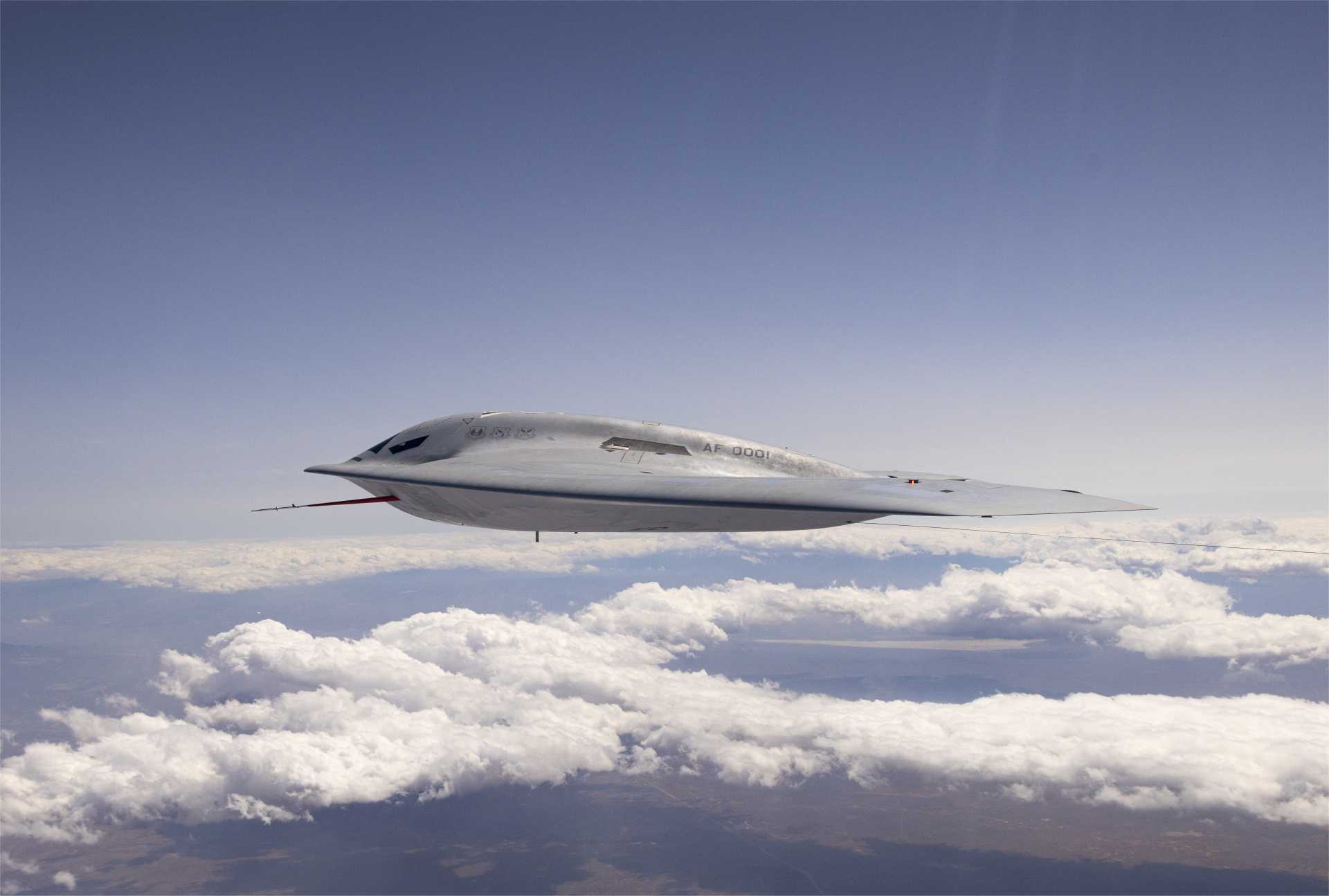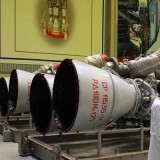Exclusive: US Air Force Targets Up to 200 B-21 Raiders for Next-Gen Strategic Stealth Bomber Fleet

{loadposition bannertop}
{loadposition sidebarpub}
The U.S. Department of Defense has reaffirmed its commitment to the B-21 Raider stealth bomber program in its Fiscal Year 2025 budget request, ensuring the continued Engineering and Manufacturing Development (EMD) phase and the transition into Low-Rate Initial Production (LRIP). The budget also includes funds for the procurement of long-lead parts, an essential step in ramping up production. As a next-generation long-range, highly survivable, and penetrating strike bomber, the B-21 Raider is designed to replace the B-1 Lancer and B-2 Spirit incrementally, ultimately becoming the backbone of the U.S. Air Force’s bomber fleet.
A B-21 Raider undergoes flight testing at Edwards Air Force Base, California, performing ground evaluations, taxiing, and airborne operations. (Picture source: U.S. DoD)
The U.S. Air Force initially planned to procure 100 B-21 Raiders, but studies have suggested increasing the total order to between 145 and 200 aircraft to ensure the force’s future strike capabilities. In February 2016, the head of the Air Force Global Strike Command indicated that the Air Force could expand the order beyond the initial 100 bombers, reaching a full fleet of up to 175-200 aircraft. A 2017 USAF study further proposed increasing the initial purchase to 145 aircraft, reinforcing the program’s strategic importance.
Previously known as the Long-Range Strike Bomber (LRS-B), the B-21 Raider is not just another aircraft; it represents a revolutionary shift in stealth, survivability, and deep-strike capability. Developed to operate in contested airspace and penetrate the most advanced air defense systems, the B-21 is built for both conventional and nuclear deterrence missions. The U.S. Air Force has prioritized this aircraft as a critical asset for its global strike capabilities, ensuring superiority over adversaries well into the future.
Manufacturing of the B-21 takes place at Air Force Plant 42 in Palmdale, California, where Northrop Grumman also produced the B-2 Spirit in the 1980s and 1990s. By the summer of 2019, reports confirmed that construction of the first B-21 aircraft was already underway. In early 2021, multiple sources reported that as the first B-21 approached completion, construction on the second unit had begun. By February 2022, six B-21 aircraft were confirmed to be under construction, with around 8,000 Northrop Grumman employees and more than 400 suppliers from at least 40 states working on the program.
On December 2, 2022, the world got its first look at the B-21 Raider as it was unveiled at Northrop Grumman’s production facility in Palmdale, California. Northrop Grumman CEO Kathy Warden emphasized that the B-21 was designed with modular, open systems architecture, allowing for rapid upgrades and future technological advancements. Compared to the B-2, the B-21 is slightly smaller but features a longer range and more advanced avionics, making it an even more formidable stealth platform.
Following its unveiling, the B-21 program achieved another major milestone on November 10, 2023, when the first test flight took place at Air Force Plant 42 in Palmdale, California. As part of the ongoing testing process, three airworthy B-21 Raiders were actively participating in the test program as of September 2024. On January 23, 2024, the U.S. Air Force awarded a low-rate initial production (LRIP) contract, marking the beginning of serial production.
The B-21 Raider is set to be delivered to operational bases in the mid-2020s, and as part of its long-term basing strategy, the Air Force designated Ellsworth AFB, South Dakota, as Main Operating Base #1 (MOB#1), a decision approved on June 3, 2021. Other bases, including Whiteman AFB, Missouri, and Dyess AFB, Texas, remain key locations for future B-21 deployments.
One of the aircraft’s most critical milestones will be achieving nuclear certification, which, as directed by Congress, must occur within two years after reaching Initial Operational Capability (IOC). However, the Air Force is actively working to achieve nuclear certification as soon as possible, reinforcing the B-21’s role as a vital part of the U.S. nuclear triad.
The B-21 Raider’s mission is strategic and essential—to destroy critical targets and weaken an adversary’s ability to wage war. Its ability to operate in highly contested environments, evade detection, and execute long-range precision strikes makes it one of the most advanced and survivable bombers ever developed. Designed with next-generation stealth technology, advanced sensors, and networked warfare capabilities, the B-21 will ensure the U.S. Air Force maintains its dominance in global power projection.
The continued funding in the FY 2025 budget underscores the Air Force’s unwavering commitment to the B-21 program, securing the future of U.S. strategic bombing and ensuring that the Raider becomes the cornerstone of America’s long-range strike capabilities. By investing in a minimum of 100 B-21 Raiders, and potentially expanding the fleet to 145 or more aircraft, the U.S. is solidifying its ability to deter, project power, and strike decisively anywhere in the world for decades to come.

{loadposition bannertop}
{loadposition sidebarpub}
The U.S. Department of Defense has reaffirmed its commitment to the B-21 Raider stealth bomber program in its Fiscal Year 2025 budget request, ensuring the continued Engineering and Manufacturing Development (EMD) phase and the transition into Low-Rate Initial Production (LRIP). The budget also includes funds for the procurement of long-lead parts, an essential step in ramping up production. As a next-generation long-range, highly survivable, and penetrating strike bomber, the B-21 Raider is designed to replace the B-1 Lancer and B-2 Spirit incrementally, ultimately becoming the backbone of the U.S. Air Force’s bomber fleet.
A B-21 Raider undergoes flight testing at Edwards Air Force Base, California, performing ground evaluations, taxiing, and airborne operations. (Picture source: U.S. DoD)
The U.S. Air Force initially planned to procure 100 B-21 Raiders, but studies have suggested increasing the total order to between 145 and 200 aircraft to ensure the force’s future strike capabilities. In February 2016, the head of the Air Force Global Strike Command indicated that the Air Force could expand the order beyond the initial 100 bombers, reaching a full fleet of up to 175-200 aircraft. A 2017 USAF study further proposed increasing the initial purchase to 145 aircraft, reinforcing the program’s strategic importance.
Previously known as the Long-Range Strike Bomber (LRS-B), the B-21 Raider is not just another aircraft; it represents a revolutionary shift in stealth, survivability, and deep-strike capability. Developed to operate in contested airspace and penetrate the most advanced air defense systems, the B-21 is built for both conventional and nuclear deterrence missions. The U.S. Air Force has prioritized this aircraft as a critical asset for its global strike capabilities, ensuring superiority over adversaries well into the future.
Manufacturing of the B-21 takes place at Air Force Plant 42 in Palmdale, California, where Northrop Grumman also produced the B-2 Spirit in the 1980s and 1990s. By the summer of 2019, reports confirmed that construction of the first B-21 aircraft was already underway. In early 2021, multiple sources reported that as the first B-21 approached completion, construction on the second unit had begun. By February 2022, six B-21 aircraft were confirmed to be under construction, with around 8,000 Northrop Grumman employees and more than 400 suppliers from at least 40 states working on the program.
On December 2, 2022, the world got its first look at the B-21 Raider as it was unveiled at Northrop Grumman’s production facility in Palmdale, California. Northrop Grumman CEO Kathy Warden emphasized that the B-21 was designed with modular, open systems architecture, allowing for rapid upgrades and future technological advancements. Compared to the B-2, the B-21 is slightly smaller but features a longer range and more advanced avionics, making it an even more formidable stealth platform.
Following its unveiling, the B-21 program achieved another major milestone on November 10, 2023, when the first test flight took place at Air Force Plant 42 in Palmdale, California. As part of the ongoing testing process, three airworthy B-21 Raiders were actively participating in the test program as of September 2024. On January 23, 2024, the U.S. Air Force awarded a low-rate initial production (LRIP) contract, marking the beginning of serial production.
The B-21 Raider is set to be delivered to operational bases in the mid-2020s, and as part of its long-term basing strategy, the Air Force designated Ellsworth AFB, South Dakota, as Main Operating Base #1 (MOB#1), a decision approved on June 3, 2021. Other bases, including Whiteman AFB, Missouri, and Dyess AFB, Texas, remain key locations for future B-21 deployments.
One of the aircraft’s most critical milestones will be achieving nuclear certification, which, as directed by Congress, must occur within two years after reaching Initial Operational Capability (IOC). However, the Air Force is actively working to achieve nuclear certification as soon as possible, reinforcing the B-21’s role as a vital part of the U.S. nuclear triad.
The B-21 Raider’s mission is strategic and essential—to destroy critical targets and weaken an adversary’s ability to wage war. Its ability to operate in highly contested environments, evade detection, and execute long-range precision strikes makes it one of the most advanced and survivable bombers ever developed. Designed with next-generation stealth technology, advanced sensors, and networked warfare capabilities, the B-21 will ensure the U.S. Air Force maintains its dominance in global power projection.
The continued funding in the FY 2025 budget underscores the Air Force’s unwavering commitment to the B-21 program, securing the future of U.S. strategic bombing and ensuring that the Raider becomes the cornerstone of America’s long-range strike capabilities. By investing in a minimum of 100 B-21 Raiders, and potentially expanding the fleet to 145 or more aircraft, the U.S. is solidifying its ability to deter, project power, and strike decisively anywhere in the world for decades to come.






